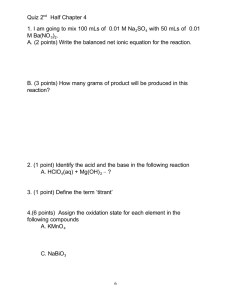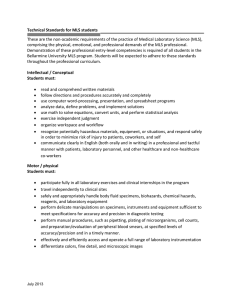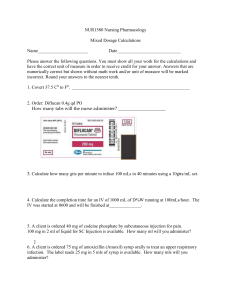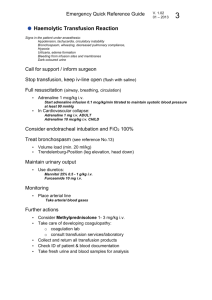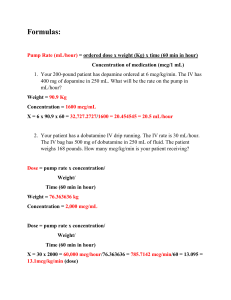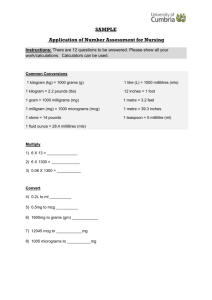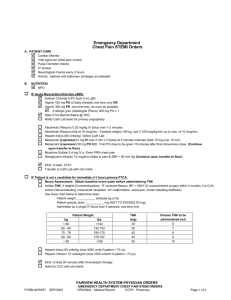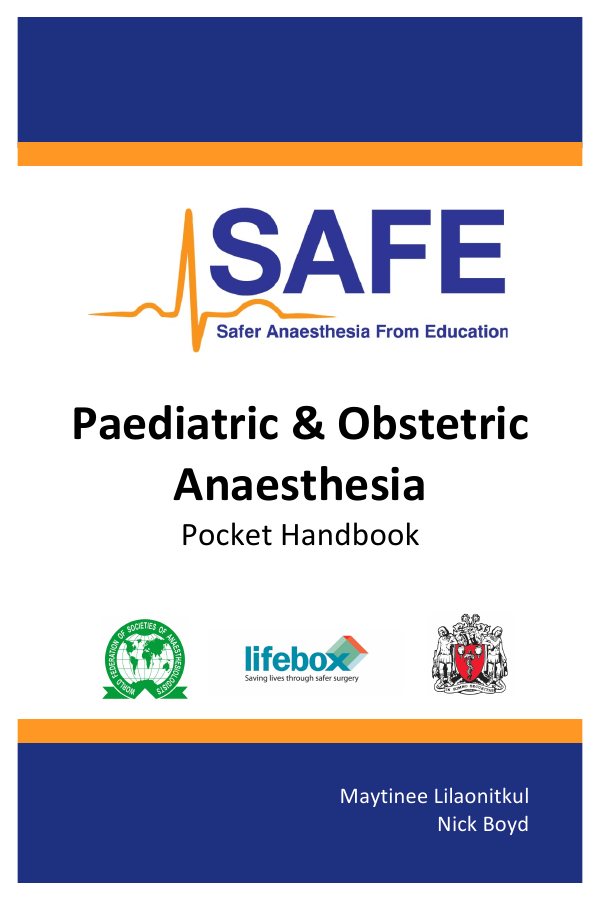
! !! ! ! ! ! ! to SAFE Project Operational Group ! Paediatric!&!Obstetric! Anaesthesia! Membership and terms of reference : Karin Pappenheim s the list of proposed members of the SAFE Project Board and the draft terms e, for discussion. Pocket'Handbook' roject board: Terms of reference tion ! ' an initiative of the AAGBI and WFSA which aims to provide education and training in esia to lower resource countries. The AAGBI’s primary focus is on delivery of' the progr WFSA’s focus is on expanding the programme to other regions. multi year project (see concept note). The role of the project board will be to' formulate and to oversee the operational delivery of the ! programme. ship ! n of IRC and one other IRC member: Rachel Collis, Paul Clyburn sident (international focus): Isabeau Walker ' Maytinee'Lilaonitkul!'! eads for SAFE topics and in country: James Leedham, David Snell, Maytinee Lilaonitk Nick'Boyd'' White. Mike Dobson? Iain Wilson? nd AAGBI senior staff: Julian Gore-Booth and ! Karin Pappenheim ecretariat staff in attendance (minutes and admin support) Paediatric!Quick!Reference! ' Normal!Physiology!ranges:! ' ' Age! Respiratory! rate!! (per'min)' Heart!! rate! (per'min)'' <!1!yr! 1–2!yr! 2–5!yr! 5–12!yr! >12!yr! 30=40' 25=35' 25=30' 20=25' 15=20' 110=160' 100=150' 95=140' 80=120' 60=100' Normal! Systolic! BP! (mmHg)! 80=90' 85=95' 85=100' 90=100' 100=120' Lowest! Systolic!! BP! (mmHg)!! 65=75' 70=75' 70=80' 80=90' 90=105' ! Weight!estimation:! (only!to!be!used!if!weighing!the!child!is!not!possible)! ! ! Birth' 6'months' 1'year' 3'–'3.5'kg' 7.5'kg' 10'kg' Over!1!year' (Age!in!years!+!4)!x!2' Above&10&years&this&formula&may&underestimate&weight& ' Emergency!drugs!and!equipment:! ! ! ETT!size!(mm)' ETT!length!(cm)' Fluid!bolus! Adrenaline!! (in'cardiac'arrest)! 10%!glucose!bolus! Atropine! Suxamethonium! Defibrillation! (Age!÷!4)!+!4.5! ETT!size!x!3! 10!–!20!ml/kg! 10!mcg/kg!IV! 0.1'ml/kg'of'1:10,000' 2!ml/kg! 20!mcg/kg!IV! 2!mg/kg!IV! 4!mg/kg'IM! 4!J/kg! ' 1' Foreword! ! Safer' Anaesthesia' From' Education' (SAFE)' obstetric' and' paediatric' courses' have' been' developed' for' anaesthesia' providers' in' low' resource'settings.'This'pocket'handbook'is'designed'to'accompany' the'SAFE'courses'and'to'be'used'in'clinical'practice.'The'aim'is'to' provide' a' quick' reference' guide' for' essential' information' and' includes' drug' doses,' important' calculations' and' management' protocols.' The' SAFE' courses' are' supported' by' the' Association' of' Anaesthetists' of' Great' Britain' and' Ireland' (AAGBI)' and' the' World' Federation' of' Societies' of' Anaesthesiologists' (WFSA).' We' would' like'to'thank'the'WFSA'for'funding'this'handbook.'' ' Disclaimer! We' have' worked' hard' to' ensure' that' all' of' the' information' provided'in'this'handbook'is'accurate'and'up'to'date.'Whilst'every' care' has' been' taken' to' ensure' that' doses' and' recommendations' are'correct,'the'responsibility'for'final'checking'must'rest'with'the' prescriber.'The'authors'cannot'accept'any'responsibility'for'errors' in'this'publication.' ' Maytinee'Lilaonitkul' Nick'Boyd' ' ' Published!January!2015! ! This'work'is'licensed'under'a'Creative'Commons'Attribution'–'Non= Commercial'4.0'International'License.'To'view'a'copy'of'this'license,' visit'http://creativecommons.org/licenses/by=nc/4.0/' ! ! ! ! ! ! ! Back!cover:'WHO'Surgical'Safety'Checklist'2009.'http://whqlibdoc.who.int/& publications/2009/9789241598590_eng_Checklist.pdf&©World&Health&Organization.&All& rights&reserved.&Reproduced'with'permission'from'the'World'Health'Organization' ' 2' Contents! Paediatric!Anaesthesia! Pre=operative'considerations' Airway'equipment' Circulation' Neonatal'anaesthesia' Pain'assessment'and'management' Caudal'and'ilioinguinal'block' Burns'fluid'resuscitation' Paediatric'anaesthetic'emergencies' • Paediatric'life'support' • Newborn'life'support' • Sick'laparotomy' • Anaphylaxis' • Status'epilepticus' • Local'anaesthetic'toxicity' • Pre=calculated'equipment'and'drugs'tables' • • • • • • • • ' Obstetric!Anaesthesia! • • • • • • ' Physiological'changes'in'pregnancy' Urgency'of'caesarean'section' Spinal'anaesthesia' General'anaesthesia' Post=operative'pain'management' Obstetric'anaesthetic'emergencies' • Maternal'basic'life'support'' • Failed'intubation' • High'spinal'and'total'spinal' • Major'obstetric'haemorrhage' • Pre=eclampsia'and'eclampsia' Drug!formulary! Lifebox!information! SBAR!handover! Anaesthetic!preparation!checklist! ' Page! ! ! 4' ' 6' 7' 9' 10' 14' 16'' 19' 20' 22' 24' 25' 26' 27' 29' ! 37' 38' 39' 42' 43' 45' 46' 48' 49' 50' 53' 56! 62! 63! 64! Paediatric!Anaesthesia! ! Pre_operative!considerations! ! Fasting!guidelines! ! Oral!intake! Clear!fluids! Breast!milk! Solids!! (including'formula'milk)! Minimum!fasting!time! (before'induction)! 2!hours! 4!hours! 6!hours! ! • Problems'associated'with'prolonged!fasting:'' ! Dehydration' ! Difficult'venous'access' ! Hypoglycaemia' ! Irritable'and'miserable'at'induction' ' • Babies'and'small'children'should'be'scheduled'first!on' an'elective'list'to'avoid'prolonged'dehydration' ' • If'the'operation'will'be'delayed,'allow'the'child'to'have' clear'fluids'until'2!hours!before!induction!of! anaesthesia' ' ' ' • Sickle!cell!patients'in'particular'should'avoid' dehydration'due'to'the'risk'of'sickle'cell'crises' 4' ' Upper!Respiratory!Tract!Infection!(URTI)!guidance! An'active'URTI'can'increase'the'risk'of'complications,'including:' • Laryngospasm'and'bronchospasm' • Airway'obstruction' • More'rapid'desaturation' Therefore,'elective!surgery'should'be'cancelled'and'postponed'for' four!weeks'if'the'following'symptoms'are'present:' • Systemic'illness'(malaise,'reduced'appetite)'with'a' fever'above'38°c' • Productive'cough' • Purulent'nasal'discharge' • Chest'signs'on'auscultation'(wheeze,'crackles,' reduced'air'entry)' ! ! High!risk!children! Children'who'need'paediatric'review,'further'pre=operative' investigations'and'possible'transfer'to'a'specialist'centre'include:' • Premature'babies'and'neonates! • Oxygen'saturations'in'air'of'less'than'94%! • Heart'disease! • Sickle'cell'disease'' • Severely'malnourished'children' • Significant'systemic'diseases' • Congenital'abnormalities'or'diseases' Heart!murmurs!are'common'and'it'can'be'difficult'to'decide'if'a' child'has'a'‘flow’'murmur'or'a'more'concerning'abnormality.' Pathological!heart!murmurs'are'generally'loud'and'may'be' associated'with'a'thrill.'Signs'that'may'indicate'significant'heart' disease'include:' • Babies:'cyanosis,'sweating'on'feeding,' hepatomegaly,'failure'to'thrive' • Younger!children:'cyanosis,'tachypnoea,'failure'to' thrive' • Older!children:'cyanosis,'history'of'reduced'exercise' tolerance,'fainting'episodes' ' 5' Airway!Equipment! ! Facemask!' ' ' Fits'comfortably'from'bridge' of'nose'to'below'the'mouth,' without'pressing'on'the'eyes' ' Oral!(Guedel)!airway! Estimated'as'the'distance' from'the'incisors'to'the'angle' of'the'jaw' ' ' Endotracheal!tube!(ETT)'' Internal'Diameter'(ID)'for'uncuffed'tube'(in'mm):' • Neonate'ETT'size'='' 3.0!–!3.5' • 1'yr'old'ETT'size'='' 4.0!–!4.5' • 2yrs'and'older'ETT'size'='' (Age!÷!4)!+!4.5' ' ETT'length'at'teeth'(in'cm)'='ETT!size!(ID)!x!3' ' Laryngeal!Mask!Airway!(LMA)! LMA!size! 1' 1½' 2' 2½' 3' ' 6' Weight!of!child! <'7.5'kg' 7.5'–'12.5'kg' 12.5'–'20'kg' 20'–'30'kg' >'30'kg' Circulation! ' ' ! Normal!physiological!values!according!to!age:' Age!! (years)! <'1' 1'='2' 2'='5' 5'='12' >'12' Heart!Rate!! (per!min)! 110'–'160' 100'–'150' 95'–'140' 80'–'120' 60'–'100' Systolic!BP! (mmHg)! 80'–'90' 85'–'95' 85'–'100' 90'–'110' 100'–'120' ! ! Estimated!Blood!Volume!=!80!mls/kg! ' ! ! ! Resuscitation!Fluids:! ! Fluid!bolus!for!resuscitation!=!10!–!20!mls/kg! ! Blood!bolus!=!8!mls/kg!of!whole!blood!!!!!!! ''''''''''''''''''''''''''(or'5mls/kg'of'packed'cells)!! ! ! ''increases!Hb!by!approximately!1g/dL! ' Glucose!bolus!=!2!mls/kg!of!10%!dextrose! 10%'dextrose'can'be'made'by'diluting'50%'dextrose' (e.g.'4mls'of'50%'dextrose'diluted'with'16mls'of'water)' ' ' ! ! Choice!of!fluid:!!! • Use'0.9%'saline'or'Ringer’s'Lactate' • NEVER'use'5%'dextrose'for'resuscitation'fluids' 7' ! Maintenance!Fluids! ! • • Always!give'oral!fluids!where!possible' If'unable'to'tolerate'oral'fluids,'use'IV'regime' below:' ! HOURLY!intravenous!fluid!requirement!(4_2_1!rule) ! 1' ! Weight!of!child! First'10kg' Second'10kg' Every'additional'kg' mls/kg/hr! 4! 2! 1! ' &&&&&&&&&&&& Example:'''Maintenance'fluids'for'a'25kg'child' ' ' ' 'first'10kg'='(4x10)'=' ' 40mls/hr' ' ' ' 'second'10kg'='(2x10)'='' 20mls/hr' ' ' ' 'additional'5kg'='(1x5)'=' '5mls/hr' ! ! !!!!!!!!Total!maintenance!fluid'requirement'='!65mls/hr' ' ! Choice!of!fluid:! • 5%'dextrose'0.9%'saline'or' • 5%'dextrose'0.45%'saline'or' • 5%'dextrose'Ringer’s'Lactate' ' • & & NEVER!use!5%!dextrose!for!maintenance!fluids!! ' ' & & & 1 Holliday'M,'Segar'W.'The'maintenance'need'for'water'in'parenteral'fluid'therapy.'Pediatr&1957;19:823O32& & 8' ' ! ' ' ' ' Neonatal!Anaesthesia! Special'Considerations' Pre_operative!assessment! • • • • Actual'weight'and'post=conceptual'age'' Assess'for'congenital'abnormalities' Ensure'Vitamin'K'has'been'given'' Check'baseline'Hb'(normally'16=18'g/dL'at'birth)' ! Preparation! • Drug'doses'calculated'and'drawn'up'before'induction' • At'least'1'unit'of'blood'cross=matched' • Warm'theatre'and'keep'baby'covered'at'all'times' ! Intra_operatively! • Use'NG'tube'to'decompress'abdominal'distension' • Keep'baby'warm'(cover'head,'warm'fluid,'warming'devices)' • Check'blood'glucose'level'and'treat'if'<3mmol/L' ! Analgesia! • Consider'local'anaesthetic'blocks'and'wound'infiltration' • Regular'paracetamol,'avoid'NSAIDs' • Cautious'use'of'opioids'(risk'of'post=operative'apnoea)' ! Postoperative!management! ' • Extubate'when'fully'awake' • Close'postoperative'monitoring'in'first'24'hours' • If'oxygen'is'required'post=operatively,'saturations'should'be' monitored'and'maintained'at'95=98%' • Premature'neonates'are'most'at'risk'of'postoperative'apnoea' ' 9' Paediatric!Pain!Assessment! ! !SeeeewqecConsidera! ' ' Use!the!most!appropriate!assessment!tool!for!the! child’s!age!or!development:! ' ' ' Age'0'='5'years' FLACC!scale' Age'4'=12'years' ' Faces!pain!scale' Age'6'years'and'above' NRS!/!VAS! • • • Face,!Legs,!Activity,!Cry,!Consolability!(FLACC)!Scale' ' ' Five'elements'to'assess'pain! Scores'added'up'to'give'total'score'out'of'10! • • ! 0! Face! Leg! Activity! Cry! Consolability! No'particular' expression'or' smile' Normal' position' Normal' position,' moving'easily' No'cry' (awake'or' asleep)' Content,' relaxed' SCORE! 1! Occasional' grimace,' disinterested' Uneasy,' restless,'tense' Squirming,' shifting'back' and'forth,'tense' Moans'or' whimpers' Reassured'by' hugging'or' being'talked'to' 2! Frequent' grimace,' clenched'jaw' Kicking'or' legs'drawn'up' Arched,'rigid' or'jerking' Crying' steadily,' screaming' Difficult'to' console'or' comfort' ! Merkel'S'et'al.'The'FLACC:'A'behavioural'scale'for'scoring'post=operative'pain'in'young'children.'' Paediatr&Nurse&1997;&23&(3):&293O7& 10' ! ! Faces!pain!scale! ! ! ! ! ! • Assessment'of'pain'based'on'child’s'facial'expression' ' Hicks'CL'et'al.'The'Faces'Pain'Scale'–'Revised:'Toward'a'common'metric'in'pediatric'pain'measurement.' Pain,&2001;&93:&173O83& ' ! Numeric!rating!scale!(NRS)!and!Visual!analogue! score!(VAS)!! ' • Child'asked'to'indicate'how'much'pain'they'have'on'a'line' with'0'being'no'pain'and'10'being'the'worst'possible'pain' • An'example'of'the'NRS'is'shown'below' ' ! '0''''''''''1'''''''''2'''''''''3'''''''''4''''''''''5'''''''''6'''''''''7'''''''''8''''''''''9''''''''10' No' Pain''' ! ! ' ' ''''''''''''Moderate' '''''''''''''''''Pain' ' '''''''''''Worst' '''''''''''''''''''''Possible'Pain' Evaluating!pain!scores:! ! PAIN!SCORE! 0! 1!_!3! 4!_!7! SEVERITY!OF!PAIN! None' Mild' Moderate' 8!_!10! Severe' ! • • • Treat'if'moderate'or'severe'pain' Reassess'30'minutes'later' Use'WHO'analgesic'ladder'to'treat'pain,'based'on'the' severity'of'pain' 11' Pain!Management! ! ' Basic!principles'!seeeewqecConsidera! • Always'use'a'multimodal!analgesia!approach:' ''''Combine'different'classes'of'analgesia'to'achieve'effective'pain' relief'with'minimal'side'effects' • Use'WHO!analgesic!ladder!! • Give'analgesics'regularly.'Do'not'wait'until'severe'pain' develops'as'it'will'be'more'difficult'to'treat' • Use'least!invasive!route.'Give'oral'medications'where'possible' • All'opioids'can'cause'respiratory!depression'and'require' careful'observation' • Ketamine!can!be!useful!for!severe!postoperative!pain.'It'has' anaesthetic'properties'so'it'should'only'be'administered'by'an' experienced'practitioner'and'requires'careful'observation' ! Adapted!WHO!Analgesic!Ladder! Step'1: ! Non=Opioids Step'2: Weak'Opioids ! + Non=Opioids !Mild'Pain''' '''Moderate'Pain' Step'3: Strong'Opioids' + Non='Opioids ! '''''''''Severe'Pain! ! Non_Opioids! Paracetamol' Ibuprofen'/'Diclofenac' Mild!Opioids! Codeine' Tramadol' Strong!Opioids! Morphine' Pethidine' Fentanyl' Adapted'from'WHO'Pain'Relief'Ladder.'www.who.int/cancer/palliative/painladder/en/' 12' Paediatric)Analgesia)Dosage)Guidelines) IV)Dose) PR)Dose) Important)notes) Paracetamol) 15mg/kg;(6(hourly( 15mg/kg;(6(hourly( 20mg/kg;(8(hourly( Max(60mg/kg/day.(Liver(damage(in(overdose( Ibuprofen) (NSAID)( 5mg/kg;(6(hourly( (Only(over(1(month)( G( G( Max(30mg/kg/day.(Avoid(in(renal(failure(and( asthmaJcs.(Do(not(use(with(other(NSAIDs( Diclofenac) (NSAID)( 1mg/kg;(8(hourly( (Only(>(6(months)( 0.5mg/kg;(8(hourly( (Only(>(2yrs(old)( 1mg/kg;(8(hourly( (Only(>6(months)( Max(150mg/day.(Avoid(in(renal(failure(and( asthmaJcs.(Do(not(use(with(other(NSAIDs( Codeine)) 1mg/kg;(6(hourly(( (Only(>12yrs(old)( G( G( Max(240mg/day.(Avoid(in(obstrucJve(sleep( apnoea.( Tramadol) 1mg/kg;(6(hourly(( (Only(>(1yr(old)( 1mg/kg(;(6(hourly( (Only(>(1yr(old)( G( CauJon(in(epilepsy( Under(1(yr(old:( 0.1mg/kg(4G6(hourly( Under(1(yr(old( Loading:(0.02G0.1mg/kg% Max%0.4mg/kg%in%4%hours% 1(yr(old(and(older:( Loading:(0.05G0.1mg/kg( Max.%5mg%per%dose,%may%be% repeated%to%max.%of%20mg% G( Calculate)EXACT)doses)for)child’s)weight) ' ' ' ' ' ' ' ' ' ' ' ' ' ' ' ' ' ' ' ' ' ' ' ' ' ' ' Oral)Dose) NON:OPIOIDS) MILD)OPIOIDS) STRONG)OPIOIDS)) Morphine) 1(yr(old(and(older:( 0.2G0.4mg/kg(4(hourly( Max.%dose%of%10mg% Prolonged(risk(of(respiratory(depression( Start(with(lowest(dose( Do(not(use(regularly(with(other(opioids( G( 0.5G1mg/kg;(4(hourly(( (Only(>1yr(old)( G( Seizures(possible(in(high(dosages( Fentanyl) G( 1G2(mcg/kg( G( Potent(respiratory(depression( Only(to(be(given(by(experienced(pracJJoner( G( 0.2(G(0.5mg/kg(IV( 2(G(4(mg/kg(IM( G( Only(to(be(given(by(experienced(pracJJoner( OTHER) Ketamine) ' ' ' 13' Pethidine) Caudal!block! Indications' • Surgery'below'umbilicus'(e.g.'inguinal'hernia,'club'foot'repair)' ' Anatomy' • The'caudal'space'is'identified'by' locating'the'sacral'hiatus,'found' at'the'apex'of'an'equilateral' triangle,'where'the'posterior' superior'iliac'spines'form'the' other'two'corners' Sacral'hiatus' Posterior'superior' iliac'spines' ' Technique' • Usually'performed'under' general'anaesthesia' • Position'patient'in'lateral'position'with'knees'drawn'into'chest' • Identify'landmarks'and'clean'skin'with'antiseptic'solution' • Using'a'22G'cannula'or'23G'needle,'insert'the'needle'into'the' sacral'hiatus'at'45°'to'skin.'If'you'hit'bone,'withdraw'slightly' and'flatten'angle'before'advancing'needle'again' • A'subtle'“give”'or'“pop”'will'be'felt'as'the'needle'enters'the' caudal'space.'If'using'a'cannula,'gently'advance'the'plastic' cannula'a'further'2mm'and'remove'the'needle.'Ensure'no'CSF' or'blood'returns'from'the'needle'or'catheter' • Attach'a'syringe'with'local'anaesthetic'(see'below),'aspirate'to' check'there'is'no'blood'and'inject'local'anaesthetic'slowly' • If'it'is'in'the'correct'position,'it'should'be'easy'to'inject'the' local'anaesthetic'and'there'should'be'no'skin'swelling' ! Local!anaesthetic!doses' ' • • • • • Use'preservative!free!bupivacaine' Scrotal/genital'surgery:'0.5!ml/kg'of'0.25%'bupivacaine' Inguinal'surgery'(T10=12):'0.75!ml/kg'of'0.25%'bupivacaine' Peri=umbilical'(T6=10):'1!ml/kg'of'0.25%'bupivacaine' 0.25%'bupivacaine'will'provide'analgesia'for'4=6'hours' Side!effects!/!risks! • Failed'block,'motor'block,'infection,'bleeding,'intravascular' injection,'urinary'retention,'inadvertent'sub=arachnoid'block' 14' ! Ilioinguinal!block! Needle'insertion' point' ASIS' • Simple'block'for'inguinal'hernia'repair'or'orchidopexy' Indications' ' • The'ilioinguinal'and' iliohypogastric'nerves'pass' through'the'external'and' internal'oblique'muscle'layers' of'the'anterior'abdominal' wall' Anatomy! ' • • • • • • • • • ' Usually'performed'under'general'anaesthesia' With'the'patient'lying'on'their'back,'expose'and'identify'the' anterior'superior'iliac'spine'(ASIS)'on'the'correct'side' Clean'the'skin'with'antiseptic'solution' The'needle'insertion'point'is'located'one!patient!finger! breadth!medial!and!inferior'to'the'ASIS'(see'diagram)'–'avoid' the'groin'skin'crease'as'this'will'be'the'surgical'incision'site' Blunt'the'tip'of'a'22G'or'23G'needle'and'insert'the'needle' perpendicular'to'the'skin'at'this'point' After'passing'through'the'skin,'advance'needle'until'a'“pop”'is' felt'as'the'needle'punctures'the'external'oblique'muscle' Aspirate'to'ensure'the'needle'is'not'in'a'blood'vessel' Inject'local'anaesthetic,'saving'approximately'1=2mls' Inject'remaining'1=2mls'of'local'anaesthetic'in'a'subcutaneous' fan'laterally,'medially'and'inferiorly'to'needle'insertion'point' Technique! ' • Use'a'volume'of'0.5mls/kg'of'0.25%'bupivacaine' • For'example'in'a'10kg'child,'use'5mls'of'0.25%'bupivacaine' Local!anaesthetic!dose! ' Side!effects!/!risks! 15' • Failed'block,'intravascular'injection,'femoral'nerve'block'(this' can'cause'temporary'leg'weakness)' Burns!Fluid!Resuscitation! ' Patients' can' lose' large' amounts' of' fluid' following' a' major' burn.' Fluid' replacement' should' be' anticipated' and' replaced' using' the' Parkland' Formula,' which' requires' an' estimation' of' the' body' surface'area'(BSA)'of'burn'–'see'next'page' & Initial!24!hours! • Hypovolaemic!shock:'IV'bolus'of'20mls/kg'of' crystalloid'fluid.'If'more'than'one'fluid'bolus' required,'look'for'other'signs'of'blood'loss'''''''''''' (e.g.'from'trauma)! • Minor!burn!(<10%!BSA):'oral'rehydration'may'be' appropriate'but'be'aware'of'post=burn'ileus,'which' may'decrease'absorption! • Major!burn!(>10%!BSA):'use'Parkland'Formula'to' estimate'fluid'requirement'in'initial'24'hours'after'a' burn! Parkland!Formula:! %!BSA!burn!!x!!Weight!!x!!4mls! ' ' • Give'this'is'the'first!24!hours:' • Give'half!the!volume!in!first!8!hours' • Give'the'remaining!half!over!next!16!hours' • In'addition'to'this,'remember'to'give'the'normal' fluid'maintenance'that'the'patient'requires' ' Subsequent!days! • 1ml'/'kg'/'%BSA'burn,'per'day'' • This'is'only'a'guide'and'fluid'replacement'should'be' based'on'clinical'findings'of'hydration'status' ! Baxter!CR,!Shires!T.!Physiologic!response!to!crystalloid!resuscitation!of!severe!burns.!! Ann#NY#Acad#Sci#1968;#150:#874#–93# ' 16' %!Body!Surface!Area!(BSA)!estimation' ' • Palmar!surface:'the'surface'of'the'patient’s'palm'(including' adducted'fingers)'is'approximately'1%'of'the'patient’s'BSA' ' ! • Wallace!Rule!of!9’s:!this'divides'the'total'BSA'into'areas'of' 9%,'as'shown'in'the'diagram.'However,'it'can'overestimate'the' extent'of'the'burn'in'young'children! ! ! ! ! ! ! ! ! ! ! ! ! ! ! ! ! ! ! ! ! ! ! ! ! Adapted'by'permission'from'BMJ'Publishing'Group'Ltd.'Initial'Management'of'Major'Burn:'II'' –'Assessment'and'Resuscitation,'Hettiaratchy'S.'BMJ&2004;&329:&101' ' 17' ' Example!of!Burns!Fluid!Resuscitation!calculation:! ' A'25kg'child'with'burns'to'front'of'chest'and'abdomen,'left'arm' and'left'leg' ' STEP!1! %!BSA!burn!estimation!! Using'Wallace'Rule'of'Nines'diagram:'18'+'9'+'13.5'='40.5%' STEP!2! Parkland!Formula' %BSA'burn'x'Weight'x'4mls'' ='40.5%'x'25kg'x'4mls' ='4050'mls'(to'be'given'in'the'first'24'hours)' STEP!3! Fluids!in!first!8!hours:' 4050mls'÷'2'='2025mls' 2025mls'÷'8'(per'hour)' ='253!mls/hr' Fluids!in!next!16!hours:' 4050mls'÷'2'='2025mls! 2025mls'÷'16'(per'hour)' ='126!mls/hr' STEP!4! Calculate!normal!maintenance!fluid!requirement!! ='65!mls/hr'(for'25kg'child,'see'page'7'for'calculation)' STEP!5! Therefore,!in!first!8!hours,!give:!253'+'65'='318!mls/hr! !!!!!!!!!!!!!!!!!in!next!16!hours,!give:!126'+'65'=!191!mls/hr! ' Choice!of!fluid:! • Use'Ringer’s'Lactate'or'0.9%'Saline' • Do!not!use'5%'dextrose'as'replacement'fluid' ' ' 18' Paediatric'Life'Support! Newborn'Life'Support! Sick'Laparotomy! Anaphylaxis! Status'Epilepticus! Local'Anaesthetic'Toxicity! ! Use'ABCDE!approach' Call'for'HELP!early' WETFLAG!mnemonic!is'useful'to'estimate' drugs'and'tube'size'for'a'child'in'an'emergency' Glucose'10%'solution'(mls)'' G! A! 19' ! (Age'+'4)'x'2' 4'J/kg' (Age'÷!4)'+'4.5' 20'mls/kg' 10'mcg/kg' 0.1mls/kg'of'1:10,000' 2'mls/kg'' W!E!T!F!L!A!G!! Weight'(kg)' Energy'(J)'for'defibrillation' Tube'(mm)' Fluid'bolus'(ml)' Adrenaline'(mcg)' W! E! T! Fl! • • • General!principles:! ! • • • • • • Topics:! ' Paediatric!Anaesthetic! Emergencies! ' Key!Points! Paediatric!Life!Support!! !' !seeeewqecConsidera! • The'most'common'cause'of'paediatric'cardiac'arrest'is'hypoxia! ! • Effective!oxygen!delivery'is'the'critical'step'in'resuscitation! ! • Use'ABC!approach! ! • It'is'important'to'provide'effective'cardiac'compressions! ! • Push'HARD,'push'FAST'and'allow'chest'to'RECOIL! ! • Depth'of'compression'is'one'third'of'anterior=posterior'depth'of' chest'and'rate'is'100'compressions'per'minute! ! • Minimise'interruptions'to'CardioPulmonary'Resuscitation'(CPR)! ! Chest!compression!techniques! ' Two'finger'technique' ' ' ' ' ' ' ' ' ' ' ' Two'thumb'technique' ' ' ' ' 20' One'hand'technique' Two'hand'technique' ' !!!!Paediatric!Basic!Life!Support! ! ! Approach!with!care! ! "! ! Stimulate! ! “Are'you'alright?”' "! ! Shout!for!help! ! "! Airway!opening!techniques! A! Head'tilt,'chin'lift' "! LOOK:!chest!movement! LISTEN:!breath!sounds! FEEL:!for!breaths! "! B! ! 5!RESCUE!BREATHS! C! Check!for!signs!of!life! Check!for!central!pulse! ! ! ! "! ! Check&for&no&more&than&10&seconds& "! ! Start!CPR! ! 15!chest!compressions!for!every!2!breaths! If'intubated'give'continuous'compressions' ' ' Give!10!mcg/kg!adrenaline!(0.1!ml/kg!of!1:10,000)!! IV'or'IO'every'3=5'minutes' ! ! ! Treatable!causes!of!cardiac!arrest! 4!H’s!and!4!T’s! • • • • Hypoxia! Hypovolaemia! Hypo_!/!Hyperkalaemia! Hypothermia! • • • • Toxins!(e.g.'deep'halothane)! Tension!pneumothorax! Tamponade!(cardiac)! Thromboembolism! '''''Adapted'from'©'Resuscitation'Council'UK'with'permission'' 21' Newborn!Life!Support!! ! ! !seeeewqecConsidera! ! Key!Points! • The'most'important'task'of'newborn'resuscitation'is'to'! HELP!THE!BABY!BREATHE'! • If'there'is'thick'meconium'and'no'respiratory'effort,'suction' the'airway'but'DO!NOT!DELAY!RESCUE!BREATHS! • There'is'little'benefit'in'starting'chest'compressions'if'airway'is' not'open'and'the'lungs'are'not'inflated! • Start'chest'compressions'if!heart!rate!is!<60'beats'per'minute! • Resuscitation'attempts'should'be'stopped'if'there'is'no'heart' beat'after'20'minutes! ' APGAR!scoring! • The'APGAR'score'should'be'performed'at'one!and!five!minutes' after'delivery,'to'indicate'the'overall'status'of'the'baby' • APGAR'scoring'should!not!delay!resuscitation'' • A'score'of'above'7'at'one'minute'is'normal' • A'score'of'3'is'critically'low'' • A'score'of'below'7'at'5'minutes'is'low'and'indicates'the'baby' may'need'ongoing'resuscitation'and'observation' '' APGAR!SCORING! ! Score!0! Score!1! Score!2! Activity' Floppy' Limbs'flexed' Active' Pulse'rate' <60' 60'='100' >100' Grimace' Sneezes,' No'response' Grimace'only' (Response'to' coughs'or' stimulation)' move'away' Pink'centrally' Appearance' Pale'or'blue' Pink'all'over' with'blue' (colour)' all'over' hands'/'feet' Irregular' Regular' Respiration' No'breathing' breathing' breathing' ' Apgar'V.'A'proposal'for'a'new'method'of'evaluation'of'the'newborn'infant.'' Curr&Res&Anesth&Analg&1953;&32&(4):&260O7& & 22' Newborn!Life!Support! 'Reproduced'from'©'Resuscitation'Council'UK'with'permission'' '' 23' Sick!Laparotomy! ! ! Signs!and!symptoms!of!intra_abdominal!sepsis! • Fever'>38°C,'high'respiratory'rate,'high'heart'rate,'low'BP' seeeewqecConside • Oliguria,'altered'conscious'level,'acute'abdomen! !ra! Give!high!flow!oxygen!! ! Fluid!resuscitation! • IV!access:'2'x'20G'cannulae' • Blood!investigations:'FBC,'U&Es,'clotting,'blood'cultures,' cross'match'and!glucose' • Give!IV!fluids:'20ml/kg'of'normal'saline'and'assess'response' ' ' If!starting!Hb!is!below!7g/dl,!cross!match!and!transfuse!blood! at!the!earliest!time!possible' ! IV!antibiotics:!give!within!1!hour!of!diagnosis' Ciprofloxacin'(10'mg/kg;'max'400mg)'' or'ceftriaxone'(50'mg/kg;'max'4g)' Plus'metronidazole'(7.5'mg/kg;'max'500mg)'' Plus'gentamicin'(7'mg/kg'once'daily'dose;'max'500mg)' ! Analgesia' • Treat'according'to'severity'of'pain' • Avoid'NSAIDs'and'IM'injections'' ! Insert!NG!tube!and!urinary!catheter' ! Definitive!management:!Surgery' • Make'sure'blood'available'before'starting' • RSI'with'ketamine.'Avoid'deep'halothane.' ! Post_operative!care' • High'dependency'care'unit' • Continue'antibiotics'for'5'days.'Give'regular'analgesia' ' 24' ' Anaphylaxis! ' Diagnosis' • Signs'include'stridor,'wheeze,'desaturation,'hypotension,' tachycardia,'rash'and'airway'oedema' • May'be'associated'with'common'triggers'(e.g.'antibiotics,' muscle'relaxants,'latex'gloves)' ' Immediate!management! • • • • ABC!approach! Stop!administering!any!potential!triggers'(e.g.'antibiotics)' Give'high!flow!oxygen' Give'intramuscular!(IM)!adrenaline:' Adrenaline!dose!for!anaphylaxis! Child'under'6'years' 150mcgs'IM'(0.15mls'of'1:1000'adrenaline)' Child'6=12'years' 300mcgs'IM'(0.3mls'of'1:1000'adrenaline)' Child'over'12'years'' 500mcgs'IM'(0.5mls'of'1:1000'adrenaline)'' ' ' ' • Give'IV!fluid!resuscitation'(20ml/kg'bolus)' • Give'hydrocortisone!IV'and'consider'giving'an'antihistamine' (such'as'chlorphenamine)'if'available'–'see'table' • Monitor'heart'rate,'blood'pressure'and'oxygen'saturation'' • May'need'further'boluses'of'IV'fluid'if'hypotensive' • Adrenaline'dose'may'be'repeated'after'5'minutes'if'needed' ' ' ' ' ' Hydrocortisone' Chlorphenamine' ''(IM'or'slow'IV)' '''(IM'or'slow'IV)' Child'under'6'months'''''''''25mg' ' 6'months'='6'years' ''''''''50mg' ' 6'=12'years'''''''' '''''''100mg'' Child'over'12'years'' '''''''200mg'' ! '''''''250mcg/kg' '''''''''''2.5mg' '''''''''''''5mg' '''''''''''10mg' '' Adapted'from'©'Resuscitation'Council'UK'with'permission'' ' 25' ' Status!Epilepticus! ' ' ' ' ' ' ! STEP!1! High!flow!oxygen! DON’T!FORGET!TO!CHECK!GLUCOSE!' "'0' VASCULAR!ACCESS! "'5&minutes' Lorazepam!0.1mg/kg!IV/IO! (or!Diazepam!0.2mg/kg!IV/IO)!! or' Diazepam!0.5mg/kg!PR! (if'no'vascular'access)' ' STEP!2! ' ' ! STEP!3! "'10&minutes' Lorazepam!0.1mg/kg!IV/IO! (or!Diazepam!0.2mg/kg!IV/IO)! CALL'FOR'HELP' "'10&minutes' Phenytoin!20mg/kg!over!20!min!IV/!IO! or' Phenobarbitone!20mg/kg!over!20!min!IV/IO! ' STEP!4! "'20&minutes' RSI!with!Thiopentone!4mg/kg!IV! Manage'patient'in'critical'care'environment' ' ' 26' Local!Anaesthetic!Toxicity! ' Signs!of!toxicity:! 1! • Neurological:'Agitation,'alteration'in'mental' state,'loss'of'consciousness,'convulsions' • Cardiac:'Arrhythmias,'cardiac'arrest' Recognition! 2! Immediate! management! Stop!injecting!local!anaesthetic' Call'for'help' Maintain'airway'(may'need'intubation)' High'flow'oxygen'(give'ventilation'if'required)' Control'seizures:'give'benzodiazepine'or' thiopentone'in'small'incremental'doses' • Assess'cardiovascular'status'throughout' • • • • • In!circulatory!arrest:! • Start'cardio= pulmonary' resuscitation'(CPR)' • Arrhythmias'may'be' very'resistant,'may' need'prolonged' resuscitation'(>1hr)' • Give'IV'lipid' emulsion*' 3! Treatment!! Without!circulatory! arrest:! • Treat'arrythmias' and'blood'pressure' as'required! • Consider'IV'lipid' emulsion*! ! • Monitor'patient'closely'until'sustained'recovery'' • Document'all'events'in'patient'notes' 4! Follow_up!! ' ' ' *!IV!lipid!emulsion,'if'available:' • Initial!bolus:'1.5'mls/kg'of'20%'lipid'solution' • Followed!by!infusion:'15'mls/kg/hr'of'20%'lipid'solution' • If!no!improvement,!give!up!to!two!further!boluses!(1.5mls/kg' every'5'minutes)!and!double!the!infusion!rate!(30mls/kg/hr)' • Propofol'is'not'a'suitable'alternative'to'lipid'emulsion' ! 'Adapted'from'AAGBI'Safety'Guideline:'Management'of'Severe'Local'Anaesthetic'Toxicity'Guideline'2010' ' 27' ! ! ! ! ! ! ! ! ! ! ! ! ! ! ! ! ! ! ! ! ! ! ! ! ! 28' Pre_calculated!Equipment!and!Drugs!Table' ! 1!month!old! !!!Estimated'Weight'=!4!kg! ! Airway! ! Fluids! ! ! ETT'size' ETT'length' ! ! Drug!doses! 9!–!10.5!cm! LMA'size' _! ' ! Estimated'blood'volume' Fluid'bolus'(20mls/kg)' Whole'blood'bolus'(8mls/kg)' Packed'cells'bolus'(5mls/kg)' 10%'glucose'(2mls/kg)' Hourly'maintenance'fluid' 320!mls! 80!mls! 32!mls! 20!mls! 8!mls! 16!mls/hr! ' ! Adrenaline'(in'cardiac'arrest)' LAs! ! 3.0!–!3.5! Amoxicillin' Atracurium' Atropine' Ceftriaxone' Diclofenac' Fentanyl' Gentamicin' Ketamine' Metronidazole' Morphine'' Neostigmine' Paracetamol'' Pethidine'' Propofol' Suxamethonium' Thiopentone' 2%'Lignocaine'(max.'dose)' 0.25%'Bupivacaine'(max.'dose)' 40!mcg!IV! (0.4'mls'of'1:10,000)' 120!mg! 2!mg! 80!mcg! 200!mg! _! 4!–!8!mcg!! 8mg!(surgical'prophylaxis)' 4!–!8!mg!IV! 30!mg! 0.08!–!0.4!mg!IV! 0.2!mg!! 80!mg!PR!! _! 8!_!20!mg! 8!mg!IV! 8!–!16!mg! 0.6!ml!(without'adrenaline)! 1.4!ml!(with'adrenaline)! 3.2!ml! ' Pre_calculated!Equipment!and!Drugs!Table! ! 6!month!old! !!!Estimated'Weight'=!7!kg! ! Airway! ! Fluids! ! ! ETT'size' ETT'length' ! ! Drug!doses! LAs! 10.5!–!12!cm! LMA'size' 1! ' ! Estimated'blood'volume' Fluid'bolus'(20mls/kg)' Whole'blood'bolus'(8mls/kg)' Packed'cells'bolus'(5mls/kg)' 10%'glucose'(2mls/kg)' Hourly'maintenance'fluid' 560!mls! 140!mls! 56!mls! 35!mls! 14!mls! 28!mls/hr! ' ! Adrenaline'(in'cardiac'arrest)' ' ! 3.5!–!4.0!! Amoxicillin' Atracurium' Atropine' Ceftriaxone' Diclofenac' Fentanyl' Gentamicin' Ketamine' Metronidazole' Morphine' Neostigmine' Paracetamol'' Pethidine'' Propofol' Suxamethonium' Thiopentone' 2%'Lignocaine'(max'dose)' 0.25%'Bupivacaine'(max'dose)' 70!mcg!IV! (0.7'mls'of'1:10,000)' 210!mg! 3.5!mg! 140!mcg! 350!mg! _! 7!–!14!mcg!! 14mg!(surgical'prophylaxis)' 7!–!14!mg!IV! 52!mg! 0.14!_!0.7!mg!IV! 0.35!mg!! 140!mg!PR!! _! 14!_!35!mg! 14!mg!IV! 14!–!28!mg! 1!ml!(without'adrenaline)! 2.5!ml!(with'adrenaline)! 5.6!ml! Pre_calculated!Equipment!and!Drugs!Table! ! !!Estimated'Weight'=!10!kg! ETT'size' 4.0!–!4.5! Airway! ! ! 1!year!old! Fluids! ! ! ETT'length' ! ! ! 12!–!13.5!cm! LMA'size' 1½! ' ! Estimated'blood'volume' Fluid'bolus'(20mls/kg)' Whole'blood'bolus'(8mls/kg)' Packed'cells'bolus'(5mls/kg)' 10%'glucose'(2mls/kg)' Hourly'maintenance'fluid' 800!mls! 200!mls! 80!mls! 50!mls! 20!mls! 40!mls/hr! ' ! 100!mcg!IV! (1'ml'of'1:10,000)' 300!mg! 5!mg! 200!mcg! 500!mg! 5mg!IV!or!10mg!PR! 10!_!20!mcg!! 20mg!(surgical'prophylaxis)' 10!_!20!mg!IV! 75!mg! 0.5!_!1!mg!IV! 0.5!mg!! 200!mg!PR!! 5!_!10!mg! 20!_!50!mg! 20!mg!IV! 20!_!40!mg! LAs! Drug!doses! Adrenaline'(in'cardiac'arrest)' ! Amoxicillin' Atracurium' Atropine' Ceftriaxone' Diclofenac' Fentanyl' Gentamicin' Ketamine' Metronidazole' Morphine' Neostigmine' Paracetamol'' Pethidine'' Propofol' Suxamethonium' Thiopentone' 1.5!ml!(without'adrenaline)! 3.5!ml!(with'adrenaline)! 8!ml! 2%'Lignocaine'(max'dose)' 0.25%'Bupivacaine'(max'dose)' ! ! ! Pre_calculated!Equipment!and!Drugs!Table! 3!year!old! ! Airway! ! Fluids! ! ! ! !!Estimated'Weight'=!14!kg! ETT'size' ETT'length' ! ! Drug!doses! LAs! 15!cm! LMA'size' 2! ' ! Estimated'blood'volume' Fluid'bolus'(20mls/kg)' Whole'blood'bolus'(8mls/kg)' Packed'cells'bolus'(5mls/kg)' 10%'glucose'(2mls/kg)' Hourly'maintenance'fluid' 1100!mls! 280!mls! 112!mls! 70!mls! 28!mls! 48!mls/hr! ' ! Adrenaline'(in'cardiac'arrest)' ' ! 5.0! Amoxicillin'' Atracurium' Atropine' Ceftriaxone' Diclofenac' Fentanyl' Gentamicin' Ketamine' Metronidazole' Morphine' Neostigmine' Paracetamol'' Pethidine'' Propofol' Suxamethonium' Thiopentone' 2%'Lignocaine'(max'dose)' 0.25%'Bupivacaine'(max'dose)' 140!mcg!IV! (1.4'ml'of'1:10,000)' 420!mg! 7!mg! 280!mcg! 700!mg! 7mg!IV!or!14mg!PR! 14!_!28!mcg!! 28mg!(surgical'prophylaxis)' 14!_!28!mg!IV! 105!mg! 0.7!_!1.4!mg!IV! 0.7!mg!! 280!mg!PR!! 7!_!14!mg! 28!_!70!mg! 28!mg!IV! 28!_!56!mg! 2.1!ml!(without'adrenaline)! 4.9!ml!(with'adrenaline)! 11.2!ml! Pre_calculated!Equipment!and!Drugs!Table! 6!year!old! ! Airway! ! Fluids! ! ! ! !!Estimated'Weight'=!20!kg! ETT'size' ETT'length' ! ! Drug!doses! LAs! 18!cm! LMA'size' 2!or!2½! ' ! Estimated'blood'volume' Fluid'bolus'(20mls/kg)' Whole'blood'bolus'(8mls/kg)' Packed'cells'bolus'(5mls/kg)' 10%'glucose'(2mls/kg)' Hourly'maintenance'fluid' 1600!mls! 240!mls! 160!mls! 100!mls! 40!mls! 60!mls/hr! ' ! Adrenaline'(in'cardiac'arrest)' ! ! 6.0! Amoxicillin' Atracurium' Atropine' Ceftriaxone' Diclofenac' Fentanyl' Gentamicin' Ketamine' Metronidazole' Morphine' Neostigmine' Paracetamol'' Pethidine'' Propofol' Suxamethonium' Thiopentone' 2%'Lignocaine'(max'dose)' 0.25%'Bupivacaine'(max'dose)' 200!mcg!IV! (2'ml'of'1:10,000)' 600!mg! 10!mg! 400!mcg! 1!g! 10mg!IV!or!20mg!PR! 20!_!40!mcg!! 40mg!(surgical'prophylaxis)' 20!_!40!mg!IV! 150!mg! 1!_!2!mg!IV! 1!mg! 400!mg!PR!! 10!_!20!mg! 40!_!100!mg! 40!mg!IV! 40!_!80!mg! 3!ml!(without'adrenaline)! 7!ml!(with'adrenaline)! 16!ml! ! Pre_calculated!Equipment!and!Drugs!Table! 8!year!old! ! Airway! ! Fluids! ! ! ! !!Estimated'Weight'=!25!kg! ETT'size' ETT'length' ! ! Drug!doses! LAs! 19!cm! LMA'size' 2½! ' ! Estimated'blood'volume' Fluid'bolus'(20mls/kg)' Whole'blood'bolus'(8mls/kg)' Packed'cells'bolus'(5mls/kg)' 10%'glucose'(2mls/kg)' Hourly'maintenance'fluid' 2000!mls! 500!mls! 10!mls! 125!mls! 50!mls! 65!mls/hr! ' ! Adrenaline'(in'cardiac'arrest)' ' ! 6.5! Amoxicillin'' Atracurium' Atropine' Ceftriaxone' Diclofenac' Fentanyl' Gentamicin' Ketamine' Metronidazole' Morphine' Neostigmine' Paracetamol'' Pethidine'' Propofol' Suxamethonium' Thiopentone' 2%'Lignocaine'(max'dose)' 0.25%'Bupivacaine'(max'dose)' 250!mcg!IV! (2.5'ml'of'1:10,000)' 750!mg! 12.5!mg! 500!mcg! 1.2!g! 12.5mg!IV!or!25mg!PR! 25!_!50!mcg!! 50mg'(surgical'prophylaxis)' 25!_!50!mg!IV! 188!mg! 1.25!_!2.5!mg!IV! 1.2!mg! 500!mg!PR!! 12!_!25!mg! 50!_!125!mg! 50!mg!IV! 50!_!100!mg! 3.8!ml!(without'adrenaline)! 8.8!ml!(with'adrenaline)! 20!ml! Pre_calculated!Equipment!and!Drugs!Table! ! 10!year!old! ! Airway! ! Fluids! ! ! !!Estimated'Weight'=!30!kg! ! ETT'size' ! ETT'length' Drug!doses! LAs! 21!cm! LMA'size' 2½!or'3! ' ! Estimated'blood'volume' Fluid'bolus'(20mls/kg)' Whole'blood'bolus'(8mls/kg)' Packed'cells'bolus'(5mls/kg)' 10%'glucose'(2mls/kg)' Hourly'maintenance'fluid' 2400!mls! 600!mls! 240!mls! 150!mls! 60!mls! 70!mls/hr! ' ! Adrenaline'(in'cardiac'arrest)' ' ! 7.0! Amoxicillin' Atracurium' Atropine' Ceftriaxone' Diclofenac' Fentanyl' Gentamicin' Ketamine' Metronidazole' Morphine' Neostigmine' Paracetamol'' Pethidine'' Propofol' Suxamethonium' Thiopentone' 2%'Lignocaine'(max'dose)' 0.25%'Bupivacaine'(max'dose)' ' 300!mcg!IV! (3'ml'of'1:10,000)' 900!mg! 15!mg! 600!mcg! 1.5!g! 15mg!IV!or!30mg!PR! 30!_!60!mcg!! 60mg'(surgical'prophylaxis)' 30!_!60!mg!IV! 225!mg! 1.5!_!3!mg!IV! 1.5!mg! 600!mg!PR!! 15!_!30!mg! 60!_!150!mg! 60!mg!IV! 60!_!120!mg! 4.5!ml!(without'adrenaline)! 10.5!ml!(with'adrenaline)! 24!ml! ' ! 36' ' ' ' ' ' ' ' ' ' ' ' ' ' ' ' ' ' ' ' ' ' ' ' ' ' ' ' ' Obstetric!Anaesthesia! ! Physiological!changes!in!pregnancy! ! Cardiovascular! system! ! Respiratory! system! ! Gastrointestinal! system! ! Renal!system! • Increase!in'blood!volume'(50%'increase)' • Increase!in!red!cell!mass'(30%'increase)' • Physiological!anaemia!of!pregnancy'' (10=20%'decrease'in'Hb'concentration)' • Increase!in!cardiac!output'(50%'increase)' • Aortocaval!compression,'most'marked' when'mother'is'lying'flat'on'back' st • Hyper_coagulable'state'after'1 'trimester' ! • Swelling!of!airway'soft'tissues'which'can' make'intubation'more'difficult! • Increase!in!minute!ventilation'leading'to' respiratory'alkalosis! • Increase!in!oxygen!consumption!(25%' increase)'making'the'mother'more' susceptible'to'hypoxia! • Upward!displacement!of!diaphragm!by' uterus'leading'to'reduced'tidal'volumes! ! • Slower!gastric!emptying'during'labour' which'increases'risk'of'reflux'and' regurgitation! • Increased!risk!of!aspiration'under'general' anaesthesia! ! • Increase'in'renal'blood!flow! • Fall'in'urea'and'creatinine'levels' ' ' 37' Urgency!of!Caesarean!Section! ! ' Key!points:! !seeeewqecConsidera! • Timing'depends'on'the'indication'for'surgery'and'the' condition'of'the'mother'and'fetus' • Good'communication'with'obstetric'team'is'vital'' • Regardless'of'urgency,'ensure'mother’s'condition'is' stabilised'as'much'as'possible'before'surgery' ! Emergency:!Immediate'threat'to'the'life'of'the'mother'or'fetus' Timing:' Examples:& As'soon'as'possible,'ideally'within'30'minutes' • • • • Prolonged'fetal'bradycardia'secondary'to'abruption' Severe'APH'from'bleeding'placenta'praevia' Severe'fetal'distress'associated'with'cord'prolapse' Uterine'rupture' Urgent:!Maternal'or'fetal'compromise'NOT'immediately'life'threatening! Timing:' Examples:& Promptly'after'decision'has'been'made,'once'mother’s' condition'has'been'optimised' • Malpresentation'(face'or'brow)' • Failure'to'progress,'with'thick'meconium'' • Severe'PET'where'vaginal'delivery'is'not'possible'' #'need!to!control!hypertension!first' Scheduled:!No'maternal'or'fetal'compromise'but'needs'early'delivery! Timing:' Examples:& Early'but'when'safe'to'do'so' • Failed'induction'of'labour' • Breech'presentation'in'early'labour' • Macrosomic'baby'in'early'labour' Elective! Timing:' Examples:& ' 38' Delivery'at'time'to'suit'the'mother'and'maternity'services' • • • • Twin'pregnancy,'first'fetus'is'breech'presentation' Two'or'more'previous'caesarean'sections'' HIV'positive'' Herpes'simplex'infection'of'vagina' ! Spinal!Anaesthesia! ! Spinal!anaesthesia!is!the!method!of!choice!for!most!caesarean! !seeeewqecConsidera! sections,!providing!there!are!no!contraindications! ' Contra_indications:! • Maternal'refusal! • Untrained'anaesthetic'provider! • Skin'infection'at'needle'injection'site! • Severe'maternal'sepsis! 9 • Poor'clotting'function'(INR>'2'or'platelets'<80x10 /L)! ! Preparation:! ! • Obtain'consent'from'patient' • Complete'‘Pre_anaesthetic!checklist’'(page'64)' • Ensure'vasoconstrictors'and'all'equipment'for'general' anaesthesia'are'immediately'available' • Monitor!saturations'and!BP'before'and'during'procedure' • Ensure'large'bore'intravenous'access'' • Consider'preloading'patients'with'intravenous'crystalloid''''''' (10=15ml/kg)'especially'if'bleeding,!septic!or!dehydrated! • Note:!Avoid!preloading!in!pre_eclampsia! ! Technique:! ! • • • • ' • • • • • • Ensure'strict!asepsis!' Spinal'should'be'performed'at'L3/4!or!L4/5'levels' Ideally,'use'25G!or!smaller'pencil'point'spinal'needle' Do'not'inject'spinal'solution'if'patient'complains'of'pain' radiating'to'back,'legs'or'bottom' Only'use'preservative'free'local'anaesthetic' Bupivacaine'is'preferable'to'lidocaine'' Minimum'height'of'block'required'for'caesarean'section'is'T5' Ensure'antibiotics'are'given'prior'to'surgical'incision' Ensure'left!lateral!tilt'of'table'' Give'5_10iu!oxytocin!IV'at'delivery' 39' Dermatome!Map! ! ' ! ! ! ! ! ! ! ! ! ! ! ! ! ! ! ! ! ! ! ! Spinal!Anaesthetic!Dose!! ! Local!Anaesthetic! (preservative'free)' Heavy&Bupivacaine& Plain&Bupivacaine& Lidocaine& Lidocaine& ' 40' Concentration! Volume! 0.5%' 0.5%' 2%' 5%' 1.5=2.5ml' 1.2=2.0ml' 3=4ml' 1.0=1.5ml' Duration!of! block! 2=3'hours' 2=3'hours' 30=45min' 60=90min' Common!problems!with!spinal!anaesthesia! ! Problem! Management! Failed!spinal! anaesthesia! No!block!! • a'repeat'spinal'may'be'performed' ‘Patchy’/!inadequate!block!before!surgery! • Repeat'spinal'may'be'performed'but'beware'of' high'spinal'or'worsening'haemodynamic'status' Intraoperative!inadequate!block! • Inhaled'nitrous'oxide'(if'available)' • IV'opioid'(e.g.'25mcg'fentanyl).'Inform'midwife' as'baby'at'risk'of'respiratory'depression' • IV'Ketamine'(0.2=0.5mg/kg)' • Surgical'infiltration'of'local'anaesthetic'' • Convert!to!GA'if'above'measures'fail'' Hypotension! • Ensure'wedge'or'increase'left'lateral'tilt'' • Intravenous'fluid'250ml'bolus'' • Avoid'head'down'position'after'giving'heavy' bupivacaine' • Vasoactive'medication'may'be'required' • Ephedrine'(3=6mg'IV'bolus)'' • Phenylephrine'(50=100mcg'IV'bolus)' • Metaraminol'(0.5mg'IV'bolus)' • Atropine'for'bradycardia'(0.3mg'IV'bolus)' • Cautious!dosing!in!pre_eclamptic!patients' High!spinal! See'page'49' LA!toxicity! See'page'27' Post_dural! puncture! headache! • Minimise'risk'by'using'pencil'point'needle'25G' or'smaller' • Exclude'other'serious'causes'of'headache' • Avoid'dehydration'and'ensure'regular'analgesia' • Epidural'blood'patch'should'only'be'performed' by'an'experienced'practitioner' ! ! 41' General!Anaesthesia!for!Caesarean!Section! ! Indications!for!General!Anaesthesia! • Maternal!request! • Failed!regional!anaesthesia! • Urgency!of!surgery'='many'guidelines'recommend'a'GA'for' emergency'caesarean'section'because'it'is'often'quicker.' However,'the'decision'will'depend'on'the'situation,'the'patient' and'the'anaesthetist’s'preference' • Maternal!instability'='this'is'often'a'difficult'decision'and' depends'on'the'severity'of'the'maternal'condition'and'the' anaesthetist’s'preference' • Contra_indication!to!regional!anaesthesia!(see'page'39)' ' Preparation! • Pre_assess'and'consent!patient' • Give'antacid!medication,'if'available' • Complete'‘Pre_anaesthetic!checklist’'(page'64)'' • Monitor!saturations'and!BP'before'and'during'procedure' • Large!bore!IV!access'with'fluid'infusion'running' • Use!left!lateral!tilt'' • Position'head'in'optimal!position!for!intubation'and'plan'for' potentially!difficult!intubation'(see'Failed'Intubation'Plan)' ' Technique! • Pre_oxygenate!mother'for'3'minutes'' • Use'Rapid!Sequence!Induction'(RSI)'' • Suxamethonium'is'advised'as'muscle'relaxation'at'induction' • All'opioids'and'anaesthetic'drugs'can'be'transmitted'to'the' baby'before'delivery'–'inform!midwife!as!baby!at!risk!of! respiratory!depression' • Give'antibiotics!early,'ideally'before'knife'to'skin' • Deep'halothane'can'contribute'to'uterine'atony' • Give'5_10iu!oxytocin'at'delivery' • Extubate'mother'fully!awake'to'avoid'aspiration' ' 42' Post_operative!Pain!Management! ! ! Key!Points! • Caesarean'sections'are'painful'post=operatively' • All'patients'should'be'offered'analgesia' • Pain'is'associated'with'worse'outcomes,'including'a'delay'to' mobilise,'poor'coughing,'increased'risk'of'chest'infections'and' a'longer'hospital'stay' ' ' ' • The'same'principles'for'managing'pain'apply'as'those' described'on'page'9' ' • Use'the'WHO'analgesic'ladder'to'treat'pain' • Most'analgesics'are'safe'to'give'while'breastfeeding,'but'use' opioids'with'caution'as'they'can'be'transmitted'to'the'baby'in' breast'milk,'making'the'baby'more'drowsy' ' ! ! Example!analgesic!regime!after!caesarean!section! Mild!Pain! • Paracetamol'1g'every'6'hours' • Consider'adding'NSAID'(e.g.'Diclofenac'50mg'8'hourly)'–' avoid'in'PET' Moderate!Pain! • As'with'mild'pain'PLUS:' • Codeine'Phosphate'30=60mg'4'hourly'(max.'240mg'per'day)' or'Tramadol'50=100mg'6'hourly' Severe!Pain! • As'with'mild'pain'PLUS:' • Oral'morphine'10=20mg'every'2'hours,'as'required' ' ' 43' ' ' ' ' ' ' ' ' ' ' ' ' ' ' ' ' ' ' ' ' ' ' ' ' ' ' ' ' ' ' 44' ' Obstetric!Anaesthetic! Emergencies! ' ' ' Topics:! ! ' • • • • • Maternal'Basic'Life'Support' Failed'Intubation'' High'Spinal'and'Total'Spinal' Major'Obstetric'Haemorrhage' Pre=eclampsia'and'Eclampsia' ' ' ! ! ! ! ! ' ' ' ' 45' ' Maternal!Basic!Life!Support! ! !seeeewqecConsidera! ! ! ! ! Key!Points! • Minimise!aorto!caval!compression'='the'mother'must'be'tilted' to'the'left.'Tilt'can'be'achieved'by'wedge'or'pillow'under'right' hip.'If'not'available,'get'an'assistant'to'kneel'and'wedge'the' patient’s'right'hip'onto'the'knees'of'the'assistant! ! • Early!intubation'is'helpful'as'hypoxia'occurs'rapidly'in'pregnant' patients! ! • Caesarean!section!should!be!performed!within!5!minutes'if' the'mother'remains'in'cardiac'arrest.'This'is'to'improve' maternal'chances'of'survival! ! • A'resuscitation'team'member'should'be'ready'to'take'the'baby' to'provide'neonatal!resuscitation! ! • If'maternal'resuscitation'is'successful,'the'mother'should'be' taken'to'high'dependency'or'intensive'care'unit'for'further' management! ! ! Possible!causes!of!maternal!cardiac!arrest! ' Obstetric!causes! • Massive'haemorrhage' • Amniotic'fluid'embolus' • Eclampsia' • Peripartum'cardiomyopathy' ' ' 46' Non_obstetric!causes! • Pulmonary'embolism' • Septic'shock' • Myocardial'infarction' • Trauma' • Intracranial'haemorrhage' • Anaesthetic'complications:'LA' toxicity,'high'or'total'spinal' Maternal!Basic!Life!Support! ' Collapse!or!no!sign!of!life! ! ! "! Shout!for!help!and!call!for!obstetrician! ! ! "! A! Airway!opening!techniques! Head'tilt,'chin'lift,'jaw'thrust' B! Check!for!signs!of!breathing:!LOOK,!LISTEN,!FEEL! ! "! ! "! Left!lateral!tilt! ! ! "! ! C! Start!CPR! 30!chest!compressions!to!every!2!breaths! ! Intubate!(with!cricoid!pressure)!as!soon!as!possible! Ventilate!with!100%!oxygen! Once'intubated,'give'continuous'compressions' ' ' Establish!IV!access:!Give!1mg!adrenaline!IV! (10mls!of!1:10,000)!every!3_5!minutes! ! "! ! ! "! ! ! Deliver!baby!within!5!minutes! Continue!CPR!during!peri_mortem!caesarean! ! ! ! Immediately!treatable!causes!for!cardiac!arrest! 4!H’s!and!4!T’s! • • • • Hypoxia! Hypovolaemia! Hypo_!/!Hyperkalaemia! Hypothermia! • • • • Toxins!(Local'anaesthetic)! Tension!pneumothorax! Tamponade!(cardiac)! Thromboembolism! (pulmonary'&'amniotic'fluid)! Don’t!forget!ECLAMPSIA!as!possible!cause!in!pregnancy! 'Reproduced'from'©'Resuscitation'Council'UK'with'permission'' ' 47' ! ! Failed!Intubation!! ' ' Poor!view!or!failed!attempt!at!intubation! ' Adjust'head'position' Ease'or'adjust'cricoid'pressure' Consider'using'bougie' "' ' Second!Attempt! ' No'more'suxamethonium' "' ' UNABLE!to!INTUBATE! ' "' ' GET!HELP' ' Maintain'cricoid'pressure'' Aim!to!oxygenate!not!intubate! $ %! ' ' ' Mask!ventilation! Mask!ventilation! POSSIBLE! IMPOSSIBLE! " ' Need!to!proceed!with!surgery' ' Immediate&threat&to&life&of& ' mother' ' " "' No' Yes' ' Concentrate!on!oxygenation! ! ' Release!cricoid!pressure! "& Try!LMA! "! Cricothyroidotomy! ' " "' ' Wake!patient!! Continue! Regional'technique'' ' with'spontaneously' or'awake'intubation,' ' breathing'patient& ' 'if'possible' ' • Difficult'intubations'are'more'common'in'obstetric'anaesthesia' –'ensure'thorough'airway'assessment'prior'to'anaesthesia' • Call!for!help!as!early!as!possible! • ALWAYS!prepare!equipment!for!a!possible!difficult!airway!! ! 48' High!Spinal!and!Total!Spinal! ! High!spinal!=!Local'anaesthetic'block'extending'above'T4'level' !seeeewqecConsidera! Total!spinal!=!Intracranial'spread'of'local'anaesthetic'leading'to' ! loss'of'consciousness! ' Prompt!recognition!and!management!will!minimise!harm!to! mother!and!baby! ' Recognition! Weakness'or'tingling'of'arms,'neck'or'jaw' Nausea,'vomiting'and'feeling'faint' Marked'hypotension'or'bradycardia' Difficulty'breathing'or'coughing'' Change'in'voice'or'hoarseness' • Loss'of'consciousness' • • • • • Recognise!symptoms!and!signs!early!as!they!can!lead! to!respiratory!and!cardiac!arrest! Management! Call!for!help!and!alert!surgeon! Assess!patient!using!ABC!approach! Treatment!is!mainly!supportive!until!spinal!wears!off! A! Give'high'flow'oxygen'and'support'airway' ! May'need'intubation'–'remember!cricoid!pressure' ! ' B! Ventilate'patient'if'poor'respiratory'effort'' ! ' C' Confirm!patient!is!in!left!lateral!tilt'' ' ' ' ' ' ' Treat!hypotension:'' • IV'fluids'and'IV'vasopressors'(ephedrine,' phenylephrine,'metaraminol'or'adrenaline)' Treat!bradycardia:' • IV'atropine' Start'Cardio_Pulmonary!Resuscitation'if'patient' has'a'cardiac'arrest' Consider!delivery!of!baby,'whilst'treating'mother' Ventilation!is!usually!necessary!for!1_2!hours!until!the! spinal!block!has!worn!off!–'remember'to'provide'low' dose'anaesthetic'while'intubated'(e.g.'halothane)' ' ' 49' ' Major!Obstetric!Haemorrhage! ! ! ! Recognition!of!blood!loss!and!hypovolaemia! ! • Blood!loss!is!often!underestimated! • Better'estimation'will'help'identify'high'risk'mothers'and'will' guide'fluid'resuscitation' • Note'that'a'fall'in'BP'may'only'occur'after'2'litres'of'blood'loss' • Remember:' • Blood'soaked'large'swab'(mop)'='300mls!blood' • Blood'soaked'bed'sheet'='1000mls!blood' • Blood'soaked'bed'sheet'and'pool'on'floor'='2000mls!blood' ' Circulating!volume!lost! (%'estimated'blood'volume)' Up!to!500!ml!(10%)! 1.5!litres!(30%)' 2!litres'(40%)' ' Over!2!litres!(>40%)' Signs! No'symptoms'or'signs' Increase'in'pulse'and'respiratory' rate,'cold,'pale' Increase'in'pulse'and'respiratory' rate,'fall!in!blood!pressure,'cold,' clammy' Rapid'pulse'and'respiratory'rate,' low!blood!pressure,'cold,'clammy,' confused' ! Causes!of!obstetric!haemorrhage!(the'Four'T’s)! ! Cause! Tone! Tissue! Trauma! Thrombin! Description! Uterine'atony'(the'most'common'cause)' Retained'products'within'the'uterus'or' placental'diseases'(e.g.'placenta'accreta)' Genital'tract'trauma,'surgical'bleeding' Poor'clotting'function' ' 50' Management!of!major!obstetric!haemorrhage! ! CALL!FOR!HELP! "! Put!mother!in!left!lateral!tilt!(if!APH)! "! Give!high!flow!oxygen! If'required,'intubate'and'ventilate'patient' "! Ensure!large!bore!IV!access!! Give!IV!fluid!resuscitation' • • • • Send'blood'for'FBC,'clotting'and'cross=matching'immediately' Warmed'IV'fluids'(up'to'2000mls'crystalloid)'then'consider'blood' Blood'should'be'given'when'estimated'loss'is'>'1.5L'(30%'EBV)' Give'FFP'and'platelets'if'coagulopathic,'or'over'4'bags'of'RBC'given' "! Definitive!management! APH:!If'severe,'consider'immediate'delivery' PPH:!Treatment'will'depend'on'cause'(Four'T’s)'' ' Important!considerations!for!any!major!obstetric!haemorrhage:' ' • • • • • • Anaesthetic!considerations! GA!with!RSI!usually!indicated! –!avoid!spinal!if! cardiovascular!instability! Keep'patient'warm! Observe'blood'loss'closely' (swabs,'suction,'floor)! Monitor'urine'output! Use'of'vasopressors'may'be' required'(e.g.'ephedrine'or' dilute'adrenaline)! Give!uterotonic!drugs!in!PPH' –'see'next'page! "! Surgical!treatment!options! • Uterine'massage'if'atony! • Bimanual'uterine' compression' • Balloon'tamponade' • B=Lynch'suture' • Ligation'of'uterine/internal' iliac'arteries' • Hysterectomy' Consider!HDU!or!ICU!care!postoperatively! ' 50' ' ' Uterotonic!Drugs! 'for'the'management'of'PPH' Drug! Dose! Comment! Oxytocin! (Syntocinon)! 5!iu!IV!bolus! 40iu'infusion'over'4' hours' Ergometrine! 0.5!mg!IM'or'slow'IV' injection' Syntometrine! As&above& Carboprost! 0.25!mg!IM'every'' 15'minutes'(max.'2mg)' Misoprostol! 1!mg!PR! ! Can'cause' tachycardia,'flushing' and'hypotension' ' Extreme'caution'in' PET'or'cardiac'disease' –'can'cause'severe' hypertension' ' Combination&of& oxytocin&and& ergometrine& & Caution'in'asthmatics' –'can'cause'severe' bronchospasm' ' Can'only'be'given' rectally' ' ' ' ' ' ' ' 52' ' ' Pre_eclampsia!and!Eclampsia! ! ' Pre_eclamptic!toxaemia!(PET)! !seeeewqecConsidera! • PET'is'a'leading'cause'of'maternal'death' • It'is'characterised'by'hypertension'and'proteinuria' • It'is'a'multi=systemic'disorder'occurring'after'20'weeks'of' pregnancy' • Pathophysiological'changes'are'described'below' CVS! !! • Hypertension'(BP!>140/90mmHg)' • Reduced'intravascular'volume'but'increased' total'body'water' • Increased'sensitivity'to'vasopressors' • Increased'capillary'permeability'which'leads' to'pulmonary!and!laryngeal!oedema' Haematological! ! • Reduced'platelet'count'and'risk'of' disseminated'intravascular'coagulation' Renal! • Increased'permeability'giving'proteinuria' • Oliguria!and!renal!failure!in!severe!disease' Cerebral! ! ! • Headache,'visual'disturbance,'hyperreflexia' • Cerebrovascular!haemorrhage! • Eclampsia' Placenta! ! • Poor'perfusion'and'reduced'fetal'growth' ! Key!points!in!management!of!PET!! • Eclampsia'is'an'emergency'that'requires'immediate'treatment!!! • PET'or'eclampsia'do'not'require'immediate'caesarean'section! • It!is!essential!that!seizures!are!treated!and!blood!pressure!is! under!control!before!proceeding!to!caesarean!section! • Treatment'should'aim'to'reduce!BP!to!<140/90mmHg' • If'caesarean'section'is'required,'either'spinal'or'general' anaesthetic'technique'can'be'used'but'special'considerations' should'be'taken'(see'next'page)' • Careful'fluid'management'is'important'(see'next'page)' ! 53' Anaesthesia!for!caesarean!sections!with!PET! ! ! • Either!spinal!or!general!anaesthesia!can!be!considered! • Spinal!anaesthesia!may'be'safer'if'the'patient'is'cooperative' 9 and'is'not'coagulopathic'(platelet'count'should'be'>80x10 /L)! • Fluid'preloading'for'spinal'anaesthesia'is'not!recommended! • GA!may!be!required'if'there'is'abnormal'coagulation,'severe' haemorrhage,'frequent'seizures'or'need'for'immediate' delivery! • Make'sure'a'smaller!size!ETT'is'available'(airway'oedema)! • Aim'to!reduce!hypertensive!response!of!intubation'by'using'IV' labetalol,'magnesium'sulphate'or'fentanyl'before'induction'! • Use'smaller!doses!of!vasoconstrictors'(increased'sensitivity)! • Ergometrine!should!be!avoided! • NSAIDs!should!be!avoided'for'post=operative'analgesia! • Patient'should'be'managed!in!HDU'after'delivery! ! Fluid!management! ! ! ! • Fluid'management'can'be'difficult'in'pre=eclampsia! • Excessive'fluid'load'may'lead'to'pulmonary'oedema'but' underfilling'may'affect'renal'function'and'fetal'circulation! • Post'partum'fluid'management'needs'careful'attention'–'fluid! restrict!to!1ml/kg/hr!of'normal'saline'and'reassess'regularly! • Fluid'balance'chart'recording'all'input'and'losses'is'essential! Drugs!used!in!pre_eclampsia! ! Drug! Dose!and!Route! Comments! Methyldopa! Nifedipine! Labetalol! PO:'250mg''8'='12'hourly' PO:'5mg,'repeated'once' PO:'200mg'12'hourly'' IV:'5=10mg'every'5'mins' Maximum'of'200mg' IV:'5=10mg'every'5'mins' Maximum'of'40mg' IV:'Loading'4g'over'10'min' IM:'Loading'10g,'then' maintenance'of'5g'4'hourly' Slow'onset'of'action' Do'not'use'sublingually' Not'in'severe'asthma' May'cause'neonatal' hypoglycaemia' Can'cause'headache,' flushing,'vomiting' See'next'page'for' further'details' Hydralazine! Magnesium! Sulphate! ' 54' Management!of!Eclampsia! ! CALL!for!HELP:'obstetrician,'midwife'and'anaesthetist' "! Full!left!lateral!position! "! ABC!approach! A! Give'high'flow'oxygen'and'support'airway'(jaw'thrust,'chin'lift)' B! If'there'is'poor'respiratory'effort,'assist'with'bag'valve'mask' ventilation.'Intubation'may'be'required' C! Gain'IV'access' "! Definitive!treatment' Stopping'seizure'minimises'cerebral'hypoxia'and'oedema' Magnesium!sulphate!is!the!drug!of!choice! ' Loading!dose:!! • 4g'magnesium'sulphate'IV'(slow'injection'over'5=10'minutes)' • Follow'with'10g'(with'1ml'of'2%'lidocaine)'IM:'5g'in'each'buttock'' ' Maintenance!dose:! • 5g'magnesium'sulphate'+'1ml'2%'lidocaine'IM'every'4'hours'' • Continue'treatment'for'24'hours'after'delivery'(or'after'last'seizure)' ' Note:&If&magnesium&is&unavailable,&10mg&diazepam&IV&can&be&used& "! Further!management! • Control'high'BP'to'reduce'risk'of'cerebral'haemorrhage' • Plan'for'delivery'of'baby'once'mother'is'stable' • Cautious'fluid'management'to'minimise'risk'of'pulmonary'oedema' ! Magnesium!toxicity! Withhold'or'delay'a'further'dose'of'magnesium'if:' • Respiratory'rate'<14'per'minute' • Patella'reflexes'are'absent' • Urine'ouput'<30ml/hr'in'the'past'4'hours' ' In'case'of'respiratory'arrest:'intubate,'ventilate'and'give'1g'of'calcium' gluconate'IV'(10ml'of'10%'calcium'gluconate)'' 55' Drug!Formulary! ! A!reminder!about!drug!concentrations:! ! Calculation!of!Drug!Concentrations! ! Percentage!solutions'(e.g.'local'anaesthetics)' ' ! To!convert!a!%!solution!to!mg/ml,!multiply!by!10! ' ''''For'example:' ' ' 1%'solution'='10mg/ml' ' ' 2%'solution'='20mg/ml' ' ' 0.5%'solution'='5mg/ml' ' ' 0.25%'solution'='2.5mg/ml' ' ! Ratio!solutions'(e.g.'adrenaline)' ' ! 1:1000!means!there!is!1g!(1000mg)!in!1000mls!! or!1mg!/!ml!! ' ''''For'example:' ' 1:1000'='1mg/ml' ' 1:10,000'='0.1mg/ml'='100'mcg/ml' ' 1:100,000'='0.01mg/ml'='10'mcg/ml' ' ' ' ' 56' ! ! Paediatric!Drug!Doses' ' ' Drug! Dose! Comments! Adrenaline! (cardiac'arrest)' Adrenaline! (anaphylaxis)' 10!mcg/kg'IV' (0.1mls/kg'1:10,000)' 150!mcg'IM' (0.15mls'of'1:1000)' 300!mcg'IM' (0.3mls'of'1:1000)' 500!mcg'IM'' (0.5mls'of'1:1000)' 1!–!10!mcg/kg'IV' (0.01=0.1mls/kg' 1:10,000)' 30!mg/kg!IV' Every'8'hours' 0.5!mg/kg'IV' ' 10!–!20!mcg/kg'IV' 10!–!30!mcg/kg'IM' 40!mcg/kg'PO' 25!–!50!mcg/kg'IV' Every'6'hours' Max'safe'dose:' 2!mg/kg! 25!–!50!mg/kg'IV' Every'8'hours' Give'every'3=5'mins' in'cardiac'arrest' Child'under'6'years'' ' Child'6'–'12'years' ' Child'over'12'years' Adrenaline! (severe' hypotension)' Amoxicillin! Atracurium! Atropine! Benzylpenicillin! Bupivacaine! Cefotaxime! Ceftriaxone! 50!mg/kg'IV' Every'24'hours' Cefuroxime! 20!_!50!mg/kg'IV' Every'8'hours' Ciprofloxacin! 10!mg/kg'PO/IV' Every'8'hours' Neonate:&every&12hrs& 150!mcg/kg!IV' Cisatracurium! Can'cause' arrhythmias'with' halothane' Max.&1g&every&8hrs& Contains'penicillin' Duration'20=30'mins' Max.&1.2mg& ' Max.&2.4g&every&6hrs& Contains'penicillin' Duration'3'–'5'hours' ' Max.&12g&daily& Caution'in'penicillin' allergic'patients' Max.&4g&daily& Caution'in'penicillin' allergic'patients' Max.&1.5g&every&8hrs& Caution'in'penicillin' allergic'patients' Max.&400mg&per& dose& Duration'40=60'mins' Drug! Dose! Comments! Co_amoxiclav! (Augmentin)' 30!mg/kg'IV' Every'8'hours' Neonate&every&12hrs& 1!mg/kg'PO' Every'6'hours' Max.&1.2g&per&dose& Contains'penicillin' Codeine! Phosphate! Cyclizine! 0.5!–!1!mg/kg!IV/IM' Every'8'hours' Dexamethasone! Diamorphine! 0.1!mg/kg!IV' 20_50!mcg/kg!IV/SC' Every'6'hours' 0.2!–!0.3!mg/kg!IV' 0.5!mg/kg!PR' 0.5!mg/kg!IV/IM' 1!mg/kg'PO/PR' Diazepam! (in'seizures)' Diclofenac! Epinephrine! Erythromycin! Etomidate! see&Adrenaline! 12.5mg/kg'IV/PO' Every'6'hours' 0.15!–!0.3!mg/kg'IV' Fentanyl! 1!–!2!mcg/kg!IV' Flucloxacillin! 25!mg/kg'IV' Every'6'hours' 0.5!–!1!mg/kg'IV' Every'12'hours' 2mg/kg!IV' SLOW'IV'injection' 7!mg/kg'IV'' Once'daily' SLOW'IV'injection' Frusemide! ! Gentamicin! (surgical'prophylaxis)' Gentamicin! (treatment'of'sepsis)' Max.&60mg&per&dose& Only'use'for'children' over'12'years;'avoid' in'sleep'apnoea' Max.&per&dose:& <12yrs:&25mg& >12yrs:&50mg& Causes'drowsiness' Max.&20&mg&daily& Max.&5mg&every&6hrs& Strong'opioid'' Max.&10mg&every& 10mins&for&seizures& Max.&150mg&daily& Avoid'in'children' under'6'months' see&Adrenaline' Max.&1g&every&6hrs& Max.&dose&60mg&& Causes'adrenal' suppression' Strong'opioid,' potent'respiratory' depressant' Max.&2g&every&6hrs& Contains'penicillin' Max.&40mg&every& 8hrs.&Potent'diuretic& Max.&120mg& Max.&500mg& Monitor'gentamicin' blood'levels'closely' Drug! Dose! Comments! Glucose! (dextrose)' Glycopyrrolate! Hydrocortisone! 2!mls/kg!of'10%' glucose'IV' 10!mcg/kg!IV' 2_4!mg/kg'IV' Every'6=8'hours' 5!mg/kg'PO' Every'6=8'hours' Dilute'50%'dextrose' to'make'10%'dextr.' Max.200mg&per&dose& Max.&100mg&per& dose& Max&30&mg/kg&daily& Caution'in'asthma' and'renal'failure' Causes'salivation,' hallucinations'' As'above' Ibuprofen! Ketamine! (induction)' Ketamine! (analgesic)' Lignocaine!! (Lidocaine)' Lorazepam! Metaraminol! Metoclopramide! ! Metronidazole! ! Midazolam! ! Morphine! ! Naloxone! 1!–!2!mg/kg'IV' 5!–!10!mg/kg'IM' 0.2!–!0.5!mg/kg!IV' 2!–!4!mg/kg'IM' Max'safe'doses:' 3!mg/kg'(no'adr.)' 7!mg/kg'(with'adr.)' 0.1!mg/kg!IV' 0.5!mg!IV'bolus,'' 0.1!mg/kg'PO/IM/IV' Every'8'hours' 7.5!mg/kg!IV/PO' Every'8'hours' 0.1!–!0.2!mg/kg!IV' 0.5!mg/kg'PO/PR' Under'1'yr'old:' 0.02!–!0.1!mg/kg!IV' Max&0.4mg/kg&4hrly& 0.1!mg/kg!PO'! Every'4=6'hours' 1yr'and'older:' 0.05_0.1mg/kg!IV' Max&5mg&per&dose,& repeated&to&20mg& 0.2_0.4mg/kg'PO' every'4'hours' Max&dose&10mg! 5!–!10!mcg/kg!IV' Duration'30=90' minutes,'prolonged' by'adrenaline' Max.&4mg&per&dose& Avoid'in'children' under'12years' Max.&10mg&every& 8hrs& Max.&500mg&every& 8hrs& Repeat'dose'once'in' 10'mins'for'seizure' See'also'page'13' ' Prolonged'risk'of' respiratory' depression,'needs' close'observation:' calculate!exact! doses!for!child’s! weight! ! Max.&2mg&total& Drug! Dose! Comments! Neostigmine! 0.05!mg/kg!IV' ! Ondansetron! ! Pancuronium! Paracetamol! ! 0.15!mg/kg'IV' Every'8'hours' 0.08!–!0.15!mg/kg'IV' 15!mg/kg!PO/IV' Every'6'hours' 20!mg/kg!PR' Every'8'hours' 0.5!–!1!mg/kg!IV' Every'4'hours' 20!mg/kg!IV' 5_20!mcg/kg!IV'bolus' Max.&2.5mg&total& Add'atropine'or' glycopyrollate'to' avoid'bradycardias' Max.&4mg&per&dose& Only'over'2'yrs'old' Duration'60'minutes' Max.&60mg/kg&daily& Pethidine! Phenobarbitone! Phenylephrine! Phenytoin! Propofol! ! Rocuronium! Salbutamol! ! Suxamethonium! ! Thiopentone! ! Tramadol! 20mg/kg!IV'loading' 2!–!5!mg/kg!IV' (induction)' 0.6!mg/kg!IV' Nebulised:'' !!2.5mg'(under'5'yrs)' ''2.5_5mg'(over'5'yrs)' 2!mg/kg!IV' 4!mg/kg'IM' 2!–!4!mg/kg'IV' (induction)' 1!mg/kg!PO/IV' Every'6'hours' Vecuronium! 0.1!mg/kg!IV! Vitamin!K! 1!mg'IM' ' ' ' ' 60' Max.&400mg&daily& Only'over'1'year'old' Max.&1g&per&dose& Max&500mcg&every& 15&minutes& Slow'IV'infusion' Caution'in'egg,'nuts' or'soya'allergies' Duration'40'minutes' Causes'tachycardia' Max.&100mg&IV&& Max.&150mg&IM' ' Max.&100mg&every& 6hrs& Only'over'1'year'old' Duration'30=40'mins' ' Recommended'for' all'newborns' Obstetric!Emergency!Drug!Doses! ' Drug! Dose! Comments! Adrenaline! (cardiac'arrest)' Adrenaline! (anaphylaxis)' Adrenaline! (severe' hypotension)' Atropine! Carboprost! 1!mg'IV' (10'mls'of'1:10,000)' 500!mcg'IM'' (0.5mls'of'1:1000)' 50!mcg'IV'boluses' (0.5'ml'of'1:10,000)' Diazepam! (eclampsia)' Ephedrine! 10!mg!IV' 20!mg'PR' 3!mg!IV'bolus' Ergometrine! 0.5!mg!IV'or'IM' Slow&IV&injection& 5!–!10!mg'IV'every'' 5'mins'' 200mg!PO'12'hourly'' 5!–!10!mg'IV'every'5' mins'(max&of&200mg)' 4g!IV'loading'dose' Give'every'3=5'mins' in'cardiac'arrest' ' ' Can'cause' arrhythmias'with' halothane' ' Max.&dose&2mg& Not'to'be'given'IV' Caution'in'asthma' Can'be'repeated' once'after'10'mins' Reducing'effect'after' multiple'doses' Caution'in'PET'and' cardiac'disease' Max.&dose&40mg' Hydralazine! ! Labetolol! ! Magnesium! Sulphate! Metaraminol! Methyldopa! Misoprostol! Nifedipine! Oxytocin! (Syntocinon)' Phenylephrine! 300!–!600!mcg!IV! 250!mcg!IM' Every'15'minutes'' 0.5mg!IV'bolus' 250mg!PO'12'hourly! 1!mg!PR! 5mg!PO,'repeat'once! 5!iu!IV,'then'infusion' of'40iu'over'4'hours' 50_100!mcg'IV'bolus' Caution'in'asthma' Can'cause'neonatal' hypoglycaemia' For&full&dosing&see& page&55' Reflex'bradycardia' ' Slow'onset'of'action' ' Not'sublingual' Slow'IV'injection' ' Reflex'bradycardia' ' ' 61' ' ' ! ! ! Tips!on!using!your!Lifebox!pulse!oximeter! • Monitor'ALL'your'patients,'even'for'minor'procedures' ' • Keep'the'yellow'cover'on'whenever'possible'to'protect'your'Lifebox' ' • Only'use'soapy'water'to'clean'the'probe' ' • If'you'are'unsure'about'the'readings,'test'the'Lifebox'on'yourself' ' • You'can'plug'the'charging'lead'directly'into'the'bottom'of'the'Lifebox'–' you'do'not'need'to'use'the'stand' ' • If'the'battery'fails'and'there'is'no'mains'supply,'you'can'use'' 3'x'AA'batteries'in'place'of'the'rechargeable'battery'(remove'battery' cover).'However,'the'AA'batteries'cannot'be'recharged'so'remember'to' keep'the'rechargeable'battery'safe' ' • For'optimal'battery'life,'when'you'first'receive'the'oximeter,'use'it'on' battery'power'until'empty'and'then'charge'fully'again.'If'mains'power' supply'is'unreliable,'remember'to'charge'whenever'possible'to'ensure'you' have'as'much'battery'charge'as'possible' ' ' • The'Lifebox'can'be'used'on'the'mains'supply,'but'remove'the'rechargable' battery'if'you'use'on'mains'supply'all'the'time'to'avoid'overcharging'the' battery;'remember'to'keep'the'rechargable'battery'safe'if'you'remove'it' ' ! Are&you&having&problems&with&your&Lifebox?& Do&you&have&any&questions&or&need&support?& Is&your&Lifebox&broken?' ' WE!CAN!HELP!_!PLEASE!E_MAIL!US:! oximeters@lifebox.org! ' Please'include'these'details:'your'name,'hospital,'country,'when' you'received'the'Lifebox'and'describe'what'the'problem'is.'' We!will!e_mail!you!back.' ! www.lifebox.org! ' 62' ! ! SBAR!handover! ' Situation,!Background,!Assessment,!Response! ' • SBAR'is'a'structured'way'of'handing!over!a!patient,'requesting! help'or'referring!a!patient'to'another'hospital' • It'improves!communication!and'patient!safety' ' Situation! • Explain'the'current'situation'or'your' immediate'concern'about'a'patient' • Include'the'patient’s'name,'age'and' location' Example:&I&am&in&maternity&theatre&with&32& year&old&lady&having&a&caesarean&section& for&fetal&distress.&There&is&a&large&PPH&and& we&are&unable&to&control&the&bleeding& Background! Assessment! • Provide'the'important'background'history'' Example:&She&is&gravida&6,&she&is&HIV& positive&but&is&on&no&medications&normally& • Describe'the'vital'signs'and'your' assessment'of'the'patient'so'far' Example:&She&is&having&a&GA,&her&BP&is& 80/40&and&pulse&rate&is&120bpm.&She&has& lost&2L&blood&and&her&uterus&is&still&atonic& • Make'any'of'your'own'suggestions'' • Explain'what'response'or'help'you'would' like,'making'it'clear'so'this'is'understood' Response!/! Recommendation!! Example:&We&have&given&syntocinon,& ergometrine&and&carboprost.&She&has&had&2& units&of&blood.&The&intern&who&is&operating& would&like&senior&assistance&immediately& ' 63' ' 10_step!Anaesthetic!Preparation!Checklist! To'be'completed'at'the'start'of'every'list! ! 1! ! 2! ! 3! ! 4! ' 5! ! 6! ! 7! ! 8! ! 9! ! 10! ! Anaesthetic!machine!check! 'Perform'your'standard'anaesthetic!machine!check' 'Make'sure'the'vaporiser!is!filled! ' Oxygen!supply!and!backup' 'Check'primary!oxygen!supply' 'Check'backup!oxygen!supply! ' Airway!equipment! ' 'Ensure'following!items!are!ready,'as'a'minimum:' '''''Facemask,'Guedel,'LMA,'Laryngoscope,'ETT,'Bougie' ' Alternative!ventilation! 'Ensure'self_inflating!bag'is'immediately'available' ' Suction! ' 'Check'suction!is!available'and'working! ' Monitoring! ' 'Check'pulse!oximeter'and'BP!monitor'are'ready! ' Operating!table! ' 'Ensure'the'operating!table!can!be!tilted!! ' IV!access!and!fluids! ' 'Ensure'cannulae,'fluids'and'IV!giving!lines'are'ready! ' Drugs,!including!emergency!drugs' 'Prepare'emergency!drugs'' ' Help!' 'Where'is'your'help!and!assistance'if'you'need'it?' ' 64' Is the anaesthesia machine and medication check complete? Yes Is the site marked? Yes Not applicable Has antibiotic prophylaxis been given within the last 60 minutes? Yes Not applicable Confirm the patient’s name, procedure, and where the incision will be made. Confirm all team members have introduced themselves by name and role. (with nurse, anaesthetist and surgeon) Has the patient confirmed his/her identity, site, procedure, and consent? Yes Before skin incision Before induction of anaesthesia (with at least nurse and anaesthetist) Surgical Safety Checklist Nurse Verbally Confirms: The name of the procedure Completion of instrument, sponge and needle counts Specimen labelling (read specimen labels aloud, including patient name) Whether there are any equipment problems to be addressed (with nurse, anaesthetist and surgeon) Before patient leaves operating room Is essential imaging displayed? Yes Not applicable This checklist is not intended to be comprehensive. Additions and modifications to fit local practice are encouraged. Risk of >500ml blood loss (7ml/kg in children)? No Yes, and two IVs/central access and fluids planned Difficult airway or aspiration risk? No Yes, and equipment/assistance available To Nursing Team: Has sterility (including indicator results) been confirmed? Are there equipment issues or any concerns? To Anaesthetist: Are there any patient-specific concerns? Known allergy? No Yes Does the patient have a: To Surgeon: What are the critical or non-routine steps? How long will the case take? What is the anticipated blood loss? Is the pulse oximeter on the patient and functioning? Yes Anticipated Critical Events Revised 1 / 2009 © WHO, 2009 To Surgeon, Anaesthetist and Nurse: What are the key concerns for recovery and management of this patient? ! ! ! ! ! ! ! ! ! ! ! ! ! ! ! ! ! ! ! ! ! ! ! ! ! !
